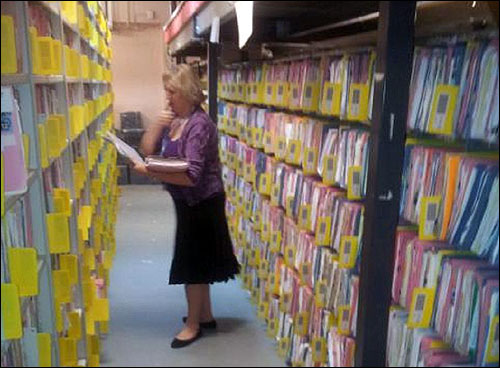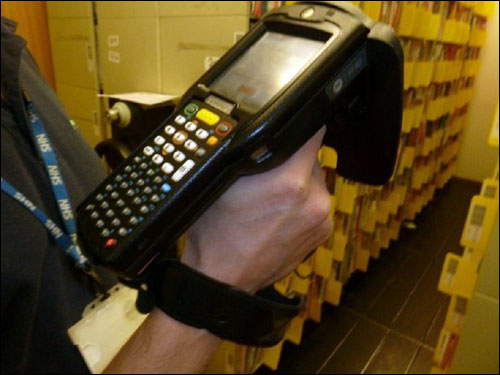Managing patient records presents a mammoth challenge for the multiple trusts (regional health-care bodies) of Great Britain’s National Health Service (NHS). Hospitals typically have thousands of records onsite, very few of which are digitized. In nearly every case, paper files are all that staff members have to provide a patient’s health history. 6PM Holdings Plc., a U.K.-based provider of IT services and products, has developed its Intelligent File and Inventory Tracking (iFIT) solution, by which passive RFID tags are attached to paper records, and handheld readers are used to track the locations of those documents on shelves, or elsewhere within the hospital.
The technology has been installed at East Surrey Hospital (Surrey and Sussex Healthcare NHS Trust), while four other trusts are currently in the process of planning or installing the technology.

The long-term solution to tracking paper records is to digitize them. Many hospitals are in the process of scanning paper files, one document at a time, in order to create digital versions. However, says Steve Wightman, 6PM’s deputy chief executive, the conversion process tends to be slow and expensive, and it will be many years before all records are stored electronically. In the meantime, Wightman adds, 6PM’s iFIT solution is intended to help hospitals manage their records efficiently until that transition is made.
Jackie Brown, the head of outpatients and health records services at the Surrey and Sussex Healthcare NHS Trust’s clinical support services division, says the manual system of locating and filing its 201,000 onsite patient records was time-consuming. “The health record could be located anywhere within our onsite and offsite facilities,” she explains. “Poor tracking means that we could often not locate health records in time for clinics, theater [operating] sessions, etc.”
The iFit solution consists of 6PM’s CareSolutions software, for managing file data such as a patient’s name and birth date, and FileTrail software, for interpreting RFID read data for the CareSolutions system. Numerous hospitals are applying FileTrail EPC Gen 2 ultrahigh-frequency (UHF) passive RFID tags to files, and are reading those tags using Motorola MC3190-Z handheld reader.
The iFIT system reduces the number of hours that hospital personnel spend putting away or locating files by 80 percent (based on the initial results at Surrey Hospital), Wightman says. The solution also frees up 10 to 15 percent of library space, he adds, since files can now be placed in the most convenient shelf location, rather than alphabetically.
Most hospitals store each patient’s paper records, whether current or archival, within a dedicated storage area, and a staff of 20 to 30 workers manage those records, retrieving them for health-care personnel and returning them to the shelves when they are returned. If a file is not returned to the records storage area, an employee must walk throughout the hospital searching for it, or make phone calls and send e-mails, if they, in fact, determine that it is missing. With the iFIT solution, a user attaches a FileTrail RFID tag to a patient’s file and scans the bar code printed on the front of that tag, in order to input its ID number into the system. That ID is then matched to that particular patient’s records in the CareSolutions software. Each time a worker moves the file, he or she utilizes a handheld reader or bar-code scanner to update the file’s status.

The process of placing a cart full of untagged files (there are typically about 100 files per cart) onto shelves can take approximately three hours, but the iFIT system is designed to complete that same task in a matter of minutes. That’s because the files can be checked in via a bar-code scanner and then be placed on the nearest or most convenient shelf. Users then scan the bar code above that shelf, thereby creating a record of that file’s location.
The system, Wightman explains, not only makes putting the files away faster, but also makes it nearly impossible for unauthorized staff members (such as a health-care worker) to simply walk into the records area and help themselves to a file stored alphabetically, based on the patient’s last name. Since the files are not shelved alphabetically, any unauthorized individual not equipped with the RFID reader, or without access to location details in the software, would have difficulty pinpointing a specific patient’s file. The iFIT solution also saves space, he says, since empty shelves can immediately be filled, rather than requiring a staff member to search for an appropriate empty space in an alphabetically arranged shelving system.
Problems could still arise with the iFIT system, Wrightman says. For example, a file could be removed from a shelf, and then be placed on another shelf without the system being updated, which would make the file virtually impossible to locate. In this case, he notes, a user could simply input the patient file ID into the handheld RFID reader, which could then indicate when he or she had come within range of that file.
The CareSolutions software can provide such services as sending staff members an alert when a file has not been returned by the expected date. Workers can then begin walking through the facility with a handheld in Geiger counter mode, and can typically read the missing file’s RFID tag—even if the staff member is standing in the hallway and the file is in a patient room—thereby making it possible to seek a file without disturbing patients.
“RFID tags, scanners and sensors [readers] enable a more automated approach,” Brown states. The iFIT system, she says, is “speedier and more accurate,” enabling staff members to place files “virtually anywhere and still find their location.”
In some cases, Wightman says, hospitals will be installing fixed RFID readers in such locations as egresses between wings. In that way, the system is updated every time an individual walks from one wing to another, indicating in which wing the file is located.
According to Wightman, the hospitals are installing the RFID system for records management first, but have indicated that they expect to expand the technology to also include the tracking of assets, personnel or high-risk patients. RFID read data from assets or individuals could also be managed with the iFIT system, he adds.


